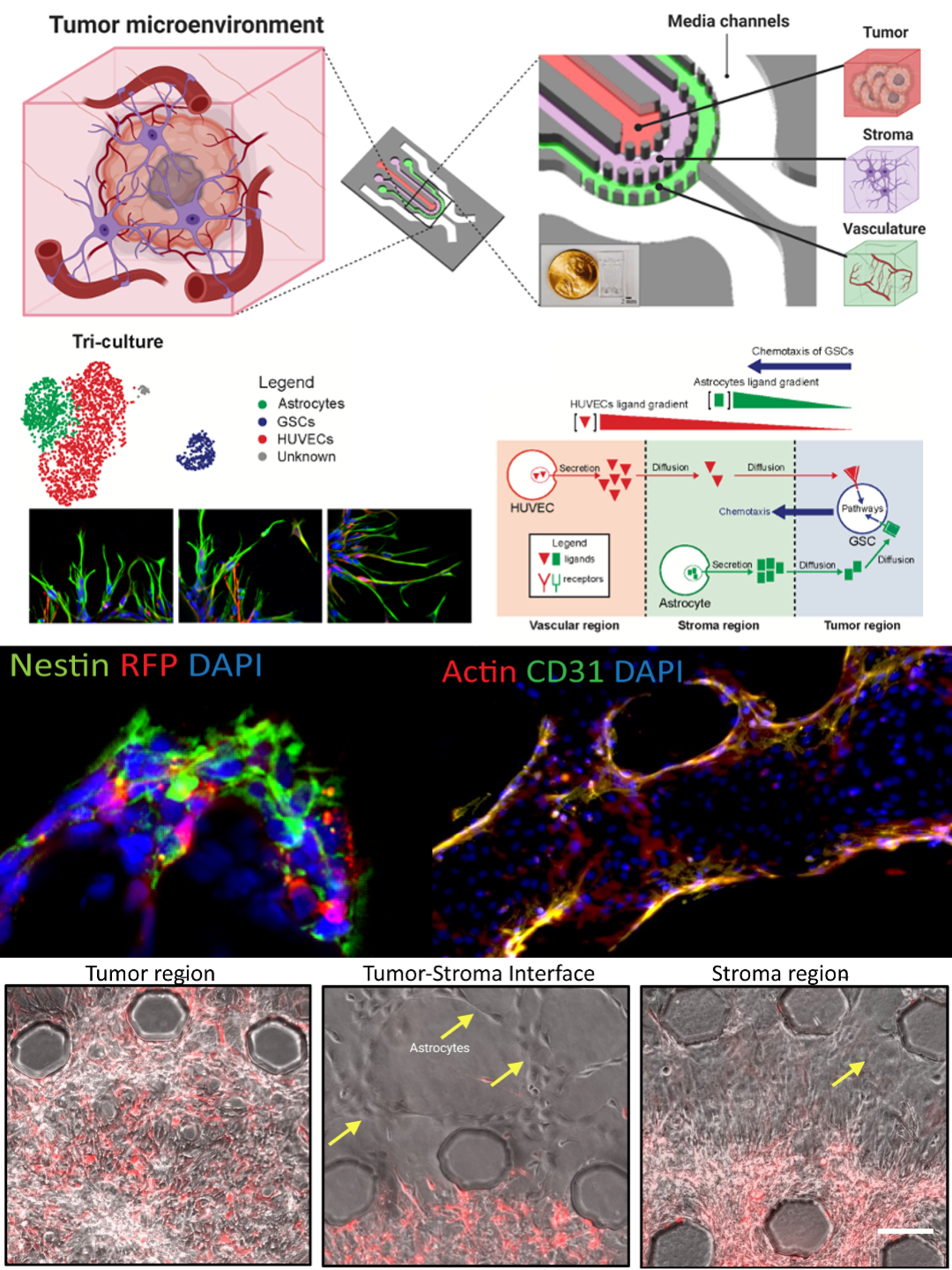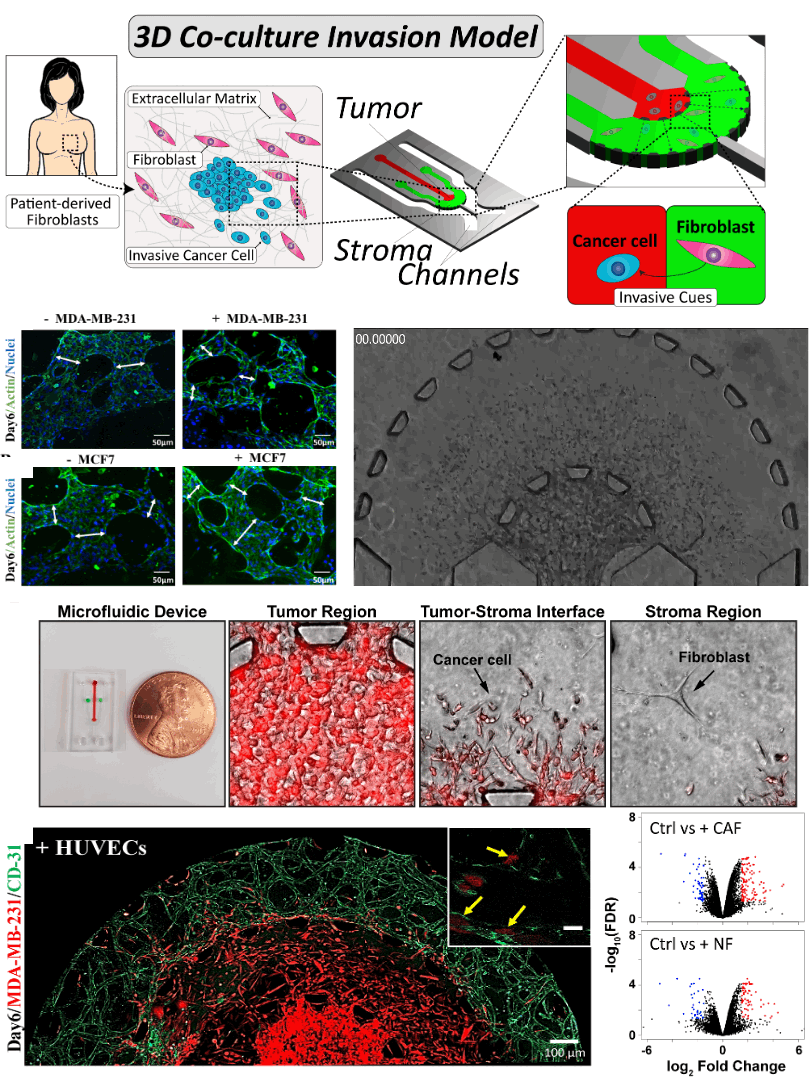Brain Tumor-on-a-Chip

Glioblastoma (GBM) is one of the deadliest forms of cancer. Despite many treatment options, prognosis of GBM remains dismal with a 5-year survival rate of 4.7%. Even then, tumors often recur after treatment. Tumor recurrence is hypothesized to be driven by glioma stem cell (GSC) populations which are highly tumorigenic, invasive, and resistant to several forms of therapy.
The perivascular niche (PVN) is a glioblastoma tumor microenvironment (TME) that serves as a safe haven for glioma stem cells (GSCs), and acts as a reservoir that inevitably leads to tumor recurrence. Understanding cellular interactions in the PVN that drive GSC treatment resistance and stemness is crucial to develop lasting therapies for glioblastoma. The limitations of in vivo models and in vitro assays have led to critical knowledge gaps regarding the influence of various cell types in the PVN on GSCs behavior. Our lab has developed an organotypic triculture microfluidic model as a means to recapitulate the PVN and study its impact on GSCs. This triculture platform, comprised of endothelial cells (ECs), astrocytes, and GSCs, is used to investigate GSC invasion, proliferation and stemness.
The vascular niche is known to provide microenvironmental cues to maintain GSC stemness as well as promote invasion and resistance to therapies. Our lab has developed a 3D organotypic microfluidic platform, integrated with hydrogel-based biomaterials, to mimic the GSC vascular niche and study the influence of endothelial cells (ECs) on patient-derived GSC behavior and identify signaling cues that mediate their invasion and phenotype.
E. A Adjei-Sowah+, S. Oconnor+, J. Veldhuizen+, C. Locasio, C. Plaisier, S. Mehta*, M. Nikkhah*, “Investigating the Interactions of the Perivascular Niche and Glioma Stem Cells, at a Single Cell Resolution level using a Microfluidic Tumor Microenvironment Model”, Advanced Science, 2201436, 2022. |
D. Truong, R. Fiorelli, E. S. Barrientos, E. L. Melendez, N. Sanai, S. Mehta*, M. Nikkhah*, “A Three Dimensional (3D) Organotypic Microfluidic Model for Glioma Stem Cells-Vascular Interactions”, Biomaterials, 198 (2019): 63-77. [Special Issue on Biomaterials and Bioengineering Innovations for Ex Vivo Tissue Chip Model Development] |
Breast Tumor-on-a-Chip Platform
Tumor-stroma interactions significantly influence cancer cell metastasis and disease progression. These interactions are partly comprised of the cross-talk between tumor and stromal fibroblasts, but the key molecular mechanisms within the cross-talk that govern cancer invasion are still unclear. We adapted our previously developed microfluidic device as a 3D in vitro organotypic model to mechanistically study tumor-stroma interactions by mimicking the spatial organization of the tumor microenvironment on a chip. We cocultured breast cancer and patient-derived fibroblast cells in 3D tumor and stroma regions, respectively, and combined functional assessments, including cancer cell migration, with transcriptome profiling to unveil the molecular influence of tumor-stroma cross-talk on invasion. This led to the observation that cancer-associated fibroblasts (CAF) enhanced invasion in 3D by inducing expression of a novel gene of interest, glycoprotein nonmetastatic B (GPNMB), in breast cancer cells, resulting in increased migration speed. Importantly, knockdown of GPNMB blunted the influence of CAF on enhanced cancer invasion. Overall, these results demonstrate the ability of our model to recapitulate patient-specific tumor microenvironments to investigate the cellular and molecular consequences of tumor-stroma interactions.
SIGNIFICANCE: An organotypic model of tumor-stroma interactions on a microfluidic chip reveals that CAFs promote invasion by enhancing expression of GPNMB in breast cancer cells.

H. Saini, J. Veldhuizen, A. Zare, M. Alaam, C. Silva, D. Truong, G. Mouneimne, J. LaBaer, R. Ros, M. Nikkhah*, “The Role of Tumor-Stroma Interactions on Desmoplasia and Tumorigenicity within a Microengineered 3D Platform”, Biomaterials, 247, 119975, 2020. |
D. Truong, A. Kratz, J. Park, E. S. Barrientos, H. Saini, T. Nguyen, B. A. Pockaj, G. Mouneimne, J. LaBaer, M. Nikkhah*, “Human Organotypic Microfluidic Tumor Model Permits Investigation of the Interplay Between Patient-derived Fibroblasts and Breast Cancer Cells”, Cancer Research, 7(12), 3139-3151, 2019. |

